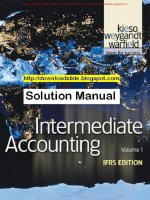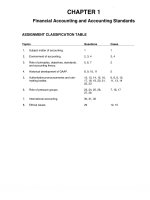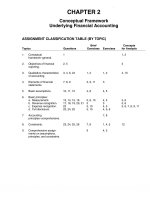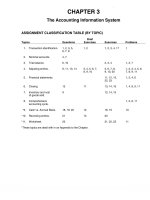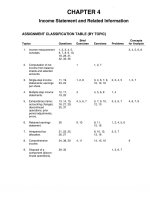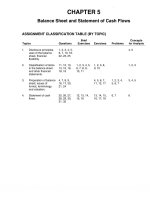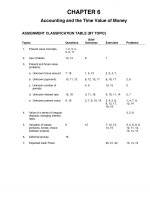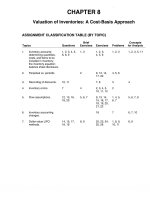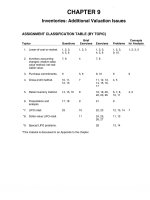Solution manual intermediate accounting 13e kieso ch03
Bạn đang xem bản rút gọn của tài liệu. Xem và tải ngay bản đầy đủ của tài liệu tại đây (420.3 KB, 82 trang )
To download more slides, ebook, solutions and test bank, visit
CHAPTER 3
The Accounting Information System
ASSIGNMENT CLASSIFICATION TABLE (BY TOPIC)
Topics
Questions
1.
Transaction identification.
1, 2, 3, 5,
6, 7, 8
2.
Nominal accounts.
4, 7
3.
Trial balance.
6, 10
4.
Adjusting entries.
8, 11, 13, 14
5.
Financial statements.
6.
Closing.
12
7.
Inventory and cost
of goods sold.
9
8.
Comprehensive
accounting cycle.
*9.
Brief
Exercises
Exercises
Problems
1, 2
1, 2, 3, 4, 17
1
2, 3, 4
1, 2, 7
5, 6, 7, 8,
9, 10, 20
1, 2, 3, 4, 5, 6,
7, 8, 9, 11
11, 12, 15,
22, 23
1, 2, 4, 6
13, 14, 16
1, 4, 8, 9, 11
3, 4, 5, 6, 7,
8, 9, 10
11
12, 14, 15
1, 2, 6, 11
Cash vs. Accrual Basis.
18, 19, 20
12
18, 19
*10.
Reversing entries.
21
13
20
*11.
Worksheet.
22
21, 22, 23
10
11
*These topics are dealt with in an Appendix to the Chapter.
Copyright © 2010 John Wiley & Sons, Inc.
Kieso, Intermediate Accounting, 13/e, Solutions Manual
(For Instructor Use Only)
3-1
To download more slides, ebook, solutions and test bank, visit
ASSIGNMENT CLASSIFICATION TABLE (BY LEARNING OBJECTIVE)
Brief
Exercises
Learning Objectives
Exercises
Problems
1.
Understand basic accounting terminology.
2.
Explain double-entry rules.
3.
Identify steps in accounting cycle.
4.
Record transactions in journals, post to ledger
accounts, and prepare a trial balance.
1, 2, 3, 4,
5, 6, 7
1, 2, 3, 4, 17
1, 4, 8, 9
5.
Explain the reasons for preparing adjusting
entries.
3, 4, 5, 6, 7,
8, 9, 10
5, 6, 7, 8,
9, 10, 20
2, 3, 4, 5, 6,
7, 8, 9, 11
6.
Prepare financial statements from the adjusted
trail balance.
11, 12, 15
1, 2, 4, 6, 7,
8, 9, 11
7.
Prepare closing entries.
11
13, 14, 16
1, 4, 8, 9, 11
*8.
Differentiate the cash basis of accounting from
the accrual basis of accounting.
12
18, 19
10
*9.
Identify adjusting entries that may be reversed.
13
20
*10.
Prepare a 10-column worksheet.
21, 22, 23
11
*These topics are dealt with in an Appendix to the Chapter.
3-2
Copyright © 2010 John Wiley & Sons, Inc.
Kieso, Intermediate Accounting, 13/e, Solutions Manual
(For Instructor Use Only)
To download more slides, ebook, solutions and test bank, visit
ASSIGNMENT CHARACTERISTICS TABLE
Level of
Difficulty
Time
(minutes)
Simple
Simple
Simple
Simple
Moderate
Moderate
Complex
Moderate
Moderate
Complex
Moderate
Moderate
Simple
Moderate
Simple
Moderate
Moderate
15–20
10–15
15–20
10–15
10–15
15–20
15–20
10–15
15–20
25–30
20–25
20–25
10–15
10–15
10–15
10–15
10–15
*E3-18
*E3-19
*E3-20
*E3-21
*E3-22
*E3-23
Transaction analysis–service company.
Corrected trial balance.
Corrected trial balance.
Corrected trial balance.
Adjusting entries.
Adjusting entries.
Analyze adjusted data.
Adjusting entries.
Adjusting entries.
Adjusting entries.
Prepare financial statements.
Prepare financial statements.
Closing entries.
Closing entries.
Missing amounts.
Closing entries for a corporation.
Transactions of a corporation, including investment
and dividend.
Cash to accrual basis.
Cash to accrual basis.
Adjusting and reversing entries.
Worksheet.
Worksheet and balance sheet presentation.
Partial worksheet preparation.
Moderate
Moderate
Complex
Simple
Moderate
Moderate
15–20
10–15
20–25
10–15
20–25
10–15
P3-1
P3-2
P3-3
P3-4
P3-5
P3-6
P3-7
P3-8
P3-9
*P3-10
*P3-11
Transactions, financial statements–service company.
Adjusting entries and financial statements.
Adjusting entries.
Financial statements, adjusting and closing entries.
Adjusting entries.
Adjusting entries and financial statements.
Adjusting entries and financial statements.
Adjusting and closing.
Adjusting and closing.
Cash and accrual basis.
Worksheet, balance sheet, adjusting and closing entries.
Moderate
Moderate
Moderate
Moderate
Moderate
Moderate
Moderate
Moderate
Moderate
Moderate
Complex
25–35
35–40
25–30
40–50
15–20
25–35
25–35
30–40
30–35
35–40
40–50
Item
E3-1
E3-2
E3-3
E3-4
E3-5
E3-6
E3-7
E3-8
E3-9
E3-10
E3-11
E3-12
E3-13
E3-14
E3-15
E3-16
E3-17
Description
Copyright © 2010 John Wiley & Sons, Inc.
Kieso, Intermediate Accounting, 13/e, Solutions Manual
(For Instructor Use Only)
3-3
To download more slides, ebook, solutions and test bank, visit
ANSWERS TO QUESTIONS
1. Examples are:
(a) Payment of an accounts payable.
(b) Collection of an accounts receivable from a customer.
(c) Transfer of an accounts payable to a note payable.
2. Transactions (a), (b), (d) are considered business transactions and are recorded in the accounting
records because a change in assets, liabilities, or owners’/stockholders’ equity has been effected as
a result of a transfer of values from one party to another. Transactions (c) and (e) are not business
transactions because a transfer of values has not resulted, nor can the event be considered financial
in nature and capable of being expressed in terms of money.
3. Transaction (a):
Transaction (b):
Transaction (c):
Transaction (d):
Accounts Receivable (debit), Service Revenue (credit).
Cash (debit), Accounts Receivable (credit).
Office Supplies (debit), Accounts Payable (credit).
Delivery Expense (debit), Cash (credit).
4. Revenue and expense accounts are referred to as temporary or nominal accounts because each
period they are closed out to Income Summary in the closing process. Their balances are reduced to
zero at the end of the accounting period; therefore, the term temporary or nominal is given to these
accounts.
5. Andrea is not correct. The double-entry system means that for every debit amount there must be a
credit amount and vice-versa. At least two accounts are affected. It does not mean that each transaction must be recorded twice.
6. Although it is not absolutely necessary that a trial balance be taken periodically, it is customary and
desirable. The trial balance accomplishes two principal purposes:
(1) It tests the accuracy of the entries in that it proves that debits and credits of an equal amount are in
the ledger.
(2) It provides a list of ledger accounts and their balances which may be used in preparing the
financial statements and in supplying financial data about the concern.
7. (a) Real account; balance sheet.
(b) Real account; balance sheet.
(c) Merchandise inventory is generally considered a real account appearing on the balance sheet. It has
the elements of a nominal account when the periodic inventory system is used. It may appear on the
income statement when the multiple-step format is used under a periodic inventory system.
(d) Real account; balance sheet.
(e) Real account; balance sheet.
(f) Nominal account; income statement.
(g) Nominal account; income statement.
(h) Real account; balance sheet.
8. At December 31, the three days’ wages due to the employees represent a current liability. The related
expense must be recorded in this period to properly reflect the expense incurred.
9. (a) In a service company, revenues are service revenues and expenses are operating expenses. In a
merchandising company, revenues are sales revenues and expenses consist of cost of goods sold
plus operating expenses.
(b) The measurement process in a merchandising company consists of comparing the sales price of
the merchandise inventory to the cost of goods sold and operating expenses.
3-4
Copyright © 2010 John Wiley & Sons, Inc.
Kieso, Intermediate Accounting, 13/e, Solutions Manual
(For Instructor Use Only)
To download more slides, ebook, solutions and test bank, visit
Questions Chapter 3 (Continued)
10. (a)
(b)
(c)
(d)
No change.
Before closing, balances exist in these accounts; after closing, no balances exist.
Before closing, balances exist in these accounts; after closing, no balances exist.
Before closing, a balance exists in this account exclusive of any dividends or the net income or net
loss for the period; after closing, the balance is increased or decreased by the amount of net income
or net loss, and decreased by dividends declared.
(e) No change.
11. Adjusting entries are prepared prior to the preparation of financial statements in order to bring the
accounts up to date and are necessary (1) to achieve a proper matching of revenues and expenses in
measuring income and (2) to achieve an accurate presentation of assets, liabilities and stockholders’
equity.
12. Closing entries are prepared to transfer the balances of nominal accounts to capital (retained earnings)
after the adjusting entries have been recorded and the financial statements prepared. Closing entries
are necessary to reduce the balances in nominal accounts to zero in order to prepare the accounts for
the next period’s transactions.
13. Cost – Salvage Value = Depreciable Cost: $4,000 – $0 = $4,000. Depreciable Cost ÷ Useful Life =
Depreciation Expense For One Year $4,000 ÷ 5 years = $800 per year. The asset was used for
6 months (7/1 – 12/31), therefore 1/2-year of depreciation expense should be reported. Annual
depreciation X 6/12 = amount to be reported on 2010 income statement: $800 X 6/12 = $400.
14.
December 31
Interest Receivable ............................................................................................................... 10,000
Interest Revenue...........................................................................................................
(To record accrued interest revenue on loan)
10,000
Accrued expenses result from the same causes as accrued revenues. In fact, an accrued expense on
the books of one company is an accrued revenue to another company.
15. No, all international companies are not subject to the same internal control standards. All public companies that list their securities on U.S. stock exchanges are subject to the internal control testing and
assurance provisions of the Sarbanes-Oxley Act of 2002. International companies that list their
securities on non-U.S. exchanges are not subject to these rules and there is debate as to whether they
should have to comply.
16. There is concern that the cost of complying with the higher internal control provisions is making U.S.
markets less competitive as a place to list securities. This in turn could give U.S. investors less
investment opportunities. On the other hand, some argue that the enhanced internal control requirements in the U.S. increase the perceived reliability of companies’ financial statements and helps
reduce their cost of capital. Furthermore, the decline in public listings in the U.S. are more likely due to
other factors, such as growth in non-U.S. markets and general globalization. Thus, the jury is still out
on the net cost/benefit of Sarbanes-Oxley and its impact on international competitiveness.
17. As with accounting standards, there are differences in auditing standards across international jurisdictions.
In the U.S., auditors of public companies are regulated by the Public Company Accounting Oversight
Board (PCAOB). The PCAOB enforces the provisions of the Sarbanes-Oxley Act through its various
auditing standards. In the international domain, the auditing standards board is the International Auditing
and Assurance Standards Board (IAASB). The IAASB is working on a broad set of international
auditing standards but to date does not have a law like Sarbanes-Oxley to guide its work.
Note to instructors—Some instructors may wish to direct students to the IAASB web-site
learn more about its work and to compare to the work of the PCAOB—
/>
Copyright © 2010 John Wiley & Sons, Inc.
Kieso, Intermediate Accounting, 13/e, Solutions Manual
(For Instructor Use Only)
3-5
To download more slides, ebook, solutions and test bank, visit
Questions Chapter 3 (Continued)
*18. Under the cash basis of accounting, revenue is recorded only when cash is received and expenses
are recorded only when paid. Under the accrual basis of accounting, revenue is recognized when it is
earned and expenses are recognized when incurred, without regard to the time of the receipt or
payment of cash.
A cash-basis balance sheet and income statement are incomplete and inaccurate in comparison to
accrual-basis financial statements. The accrual basis matches effort (expenses) with accomplishment
(revenues) in the income statement while the cash basis only presents cash receipts and cash
disbursements. The accrual basis balance sheet contains receivables, payables, accruals, prepayments,
and deferrals while a cash basis balance sheet shows none of these.
*19. Wages paid during the year will include the payment of any wages attributable to the prior year but
unpaid at the end of the prior year. This amount is an expense of the prior year and not of the current
year, and thus should be subtracted in determining wages expense. Similarly, wages paid during the
year will not include any wages attributable to hours worked during the current year but not actually
paid until the following year. This should be added in determining wages expense.
*20. Although similar to the strict cash basis, the modified cash basis of accounting requires that expenditures for capital items be charged against income over all the periods to be benefited. This is done
through conventional accounting methods, such as depreciation and amortization. Under the strict cash
basis, expenditures would be recognized as expenses in the period in which the corresponding cash
disbursements are made.
*21. Reversing entries are made at the beginning of the period to reverse accruals and some deferrals.
Reversing entries are not required. They are made to simplify the recording of certain transactions that
will occur later in the period. The same results will be attained whether or not reversing entries are
recorded.
*22. Disagree. A worksheet is not a permanent accounting record and its use is not required in the accounting cycle. The worksheet is an informal device for accumulating and sorting information needed
for the financial statements. Its use is optional in helping to prepare financial statements.
3-6
Copyright © 2010 John Wiley & Sons, Inc.
Kieso, Intermediate Accounting, 13/e, Solutions Manual
(For Instructor Use Only)
To download more slides, ebook, solutions and test bank, visit
SOLUTIONS TO BRIEF EXERCISES
BRIEF EXERCISE 3-1
May
1
3
Cash...............................................................................
Common Stock ..................................................
4,000
Equipment....................................................................
1,100
4,000
Accounts Payable.............................................
13
21
1,100
Rent Expense..............................................................
Cash ......................................................................
400
Accounts Receivable ...............................................
500
400
Service Revenue ...............................................
500
BRIEF EXERCISE 3-2
Aug.
2
7
Cash ................................................................................
12,000
Equipment .....................................................................
Agazzi, Capital.....................................................
2,500
Supplies .........................................................................
500
14,500
Accounts Payable ..............................................
12
Cash ................................................................................
Accounts Receivable.................................................
500
1,300
670
Service Revenue.................................................
Copyright © 2010 John Wiley & Sons, Inc.
Kieso, Intermediate Accounting, 13/e, Solutions Manual
(For Instructor Use Only)
1,970
3-7
To download more slides, ebook, solutions and test bank, visit
BRIEF EXERCISE 3-2 (Continued)
15
Rent Expense ...............................................................
600
Cash ........................................................................
19
600
Supplies Expense .......................................................
Supplies ($500 – $270) ......................................
230
230
BRIEF EXERCISE 3-3
July
Dec.
1
31
Prepaid Insurance.......................................................
Cash ........................................................................
15,000
Insurance Expense .....................................................
2,500
15,000
Prepaid Insurance
($15,000 X 1/2 X 1/3) ......................................
2,500
BRIEF EXERCISE 3-4
July
Dec.
1
31
Cash.................................................................................
Unearned Insurance Revenue ........................
15,000
Unearned Insurance Revenue.................................
2,500
15,000
Insurance Revenue
($15,000 X 1/2 X 1/3) ......................................
3-8
Copyright © 2010 John Wiley & Sons, Inc.
Kieso, Intermediate Accounting, 13/e, Solutions Manual
2,500
(For Instructor Use Only)
To download more slides, ebook, solutions and test bank, visit
BRIEF EXERCISE 3-5
Feb.
1
Prepaid Insurance ...................................................... 720,000
Cash........................................................................
June 30
720,000
Insurance Expense..................................................... 150,000
Prepaid Insurance
($720,000 X 5/24) ............................................
150,000
BRIEF EXERCISE 3-6
Nov.
1
Cash ................................................................................
2,400
Unearned Rent Revenue ..................................
Dec.
31
Unearned Rent Revenue...........................................
Rent Revenue
2,400
1,600
($2,400 X 2/3) ...................................................
1,600
BRIEF EXERCISE 3-7
Dec.
31
Salaries Expense ........................................................
Salaries Payable
4,800
($8,000 X 3/5) ...................................................
Jan.
2
Salaries Payable..........................................................
Salaries Expense ........................................................
4,800
4,800
3,200
Cash........................................................................
Copyright © 2010 John Wiley & Sons, Inc.
Kieso, Intermediate Accounting, 13/e, Solutions Manual
(For Instructor Use Only)
8,000
3-9
To download more slides, ebook, solutions and test bank, visit
BRIEF EXERCISE 3-8
Dec.
31
Interest Receivable .....................................................
300
Interest Revenue.................................................
Feb.
1
Cash.................................................................................
Notes Receivable ................................................
300
12,400
12,000
Interest Receivable.............................................
Interest Revenue.................................................
300
100
BRIEF EXERCISE 3-9
Aug.
31
31
Interest Expense..........................................................
Interest Payable ..................................................
300
Accounts Receivable .................................................
1,400
300
Service Revenue .................................................
31
31
1,400
Salaries Expense.........................................................
Salaries Payable..................................................
700
Bad Debt Expense ......................................................
900
700
Allowance for Doubtful Accounts.................
900
BRIEF EXERCISE 3-10
Depreciation Expense....................................................................
2,000
Accumulated Depreciation—Equipment.........................
Equipment .........................................................................................
Less: Accumulated depreciation—equipment.....................
3-10
Copyright © 2010 John Wiley & Sons, Inc.
2,000
$30,000
2,000
Kieso, Intermediate Accounting, 13/e, Solutions Manual
$28,000
(For Instructor Use Only)
To download more slides, ebook, solutions and test bank, visit
BRIEF EXERCISE 3-11
Sales...........................................................................................
808,900
Interest Revenue ....................................................................
Income Summary ..........................................................
13,500
Income Summary...................................................................
780,300
822,400
Cost of Goods Sold ......................................................
Operating Expenses.....................................................
556,200
189,000
Income Tax Expense....................................................
35,100
Income Summary...................................................................
42,100
Retained Earnings.........................................................
Retained Earnings .................................................................
42,100
18,900
Dividends .........................................................................
18,900
*BRIEF EXERCISE 3-12
(a)
(b)
Cash receipts................................................................
$142,000
+ Increase in accounts receivable
($18,600 – $13,000).............................................
5,600
Service revenue ...........................................................
$147,600
Payments for operating expenses ........................
– Increase in prepaid expenses
$ 97,000
($23,200 – $17,500).............................................
(5,700)
Operating expenses ...................................................
Copyright © 2010 John Wiley & Sons, Inc.
Kieso, Intermediate Accounting, 13/e, Solutions Manual
$ 91,300
(For Instructor Use Only)
3-11
To download more slides, ebook, solutions and test bank, visit
*BRIEF EXERCISE 3-13
(a)
Salaries Payable .................................................................
4,200
Salaries Expense........................................................
(b)
(c)
3-12
4,200
Salaries Expense ................................................................
Cash ...............................................................................
7,000
Salaries Payable .................................................................
4,200
Salaries Expense ................................................................
Cash ...............................................................................
2,800
Copyright © 2010 John Wiley & Sons, Inc.
7,000
Kieso, Intermediate Accounting, 13/e, Solutions Manual
7,000
(For Instructor Use Only)
To download more slides, ebook, solutions and test bank, visit
SOLUTIONS TO EXERCISES
EXERCISE 3-1 (15–20 minutes)
Apr.
2
Cash ................................................................................
Equipment .....................................................................
30,000
14,000
Christine Ewing, Capital ..................................
44,000
2
No entry—not a transaction.
3
Supplies .........................................................................
Accounts Payable ..............................................
700
Rent Expense ...............................................................
600
7
700
Cash........................................................................
11
12
600
Accounts Receivable.................................................
Service Revenue.................................................
1,100
Cash ................................................................................
3,200
1,100
Unearned Service Revenue ............................
17
21
3,200
Cash ................................................................................
Service Revenue.................................................
2,300
Insurance Expense.....................................................
110
2,300
Cash........................................................................
30
Salaries Expense ........................................................
Cash........................................................................
Copyright © 2010 John Wiley & Sons, Inc.
Kieso, Intermediate Accounting, 13/e, Solutions Manual
110
1,160
(For Instructor Use Only)
1,160
3-13
To download more slides, ebook, solutions and test bank, visit
EXERCISE 3-1 (Continued)
30
Supplies Expense .......................................................
120
Supplies .................................................................
30
Equipment .....................................................................
Christine Ewing, Capital...................................
120
5,100
5,100
EXERCISE 3-2 (10–15 minutes)
GERONIMO COMPANY
Trial Balance
April 30, 2010
Debit
Cash....................................................................................
$ 2,100
Accounts Receivable ....................................................
Prepaid Insurance ($700 + $1,000)............................
2,750
1,700
Equipment.........................................................................
Accounts Payable ($4,500 – $1,000) ........................
8,000
Credit
$ 3,500
Property Tax Payable....................................................
560
Geronimo, Capital ($11,200 + $3,200) ......................
14,400
Geronimo, Drawing........................................................
Service Revenue.............................................................
3,200
Salaries Expense............................................................
Advertising Expense ($1,100 + $300).......................
4,200
1,400
Property Tax Expense ($800 + $1,000)....................
1,800
6,690
$25,150
3-14
Copyright © 2010 John Wiley & Sons, Inc.
Kieso, Intermediate Accounting, 13/e, Solutions Manual
$25,150
(For Instructor Use Only)
To download more slides, ebook, solutions and test bank, visit
EXERCISE 3-3 (15–20 minutes)
The ledger accounts are reproduced below, and corrections are shown in the
accounts.
Cash
Bal.
(1)
Accounts Payable
5,912 (4)
190
Bal.
270
Accounts Receivable
Bal.
5,240 (1)
Common Stock
270
Bal.
Supplies on Hand
Bal.
7,044
8,000
Retained Earnings
2,967
Bal.
Furniture and Equipment
2,000
Service Revenue
Bal.
6,100
Bal.
5,200
(2)
1,900
(3)
2,025
(5)
80
Office Expense
Bal.
Copyright © 2010 John Wiley & Sons, Inc.
4,320 (2)
Kieso, Intermediate Accounting, 13/e, Solutions Manual
(For Instructor Use Only)
1,900
3-15
To download more slides, ebook, solutions and test bank, visit
EXERCISE 3-3 (Continued)
SCARLATTI CORPORATION
Trial Balance (Corrected)
April 30, 2010
Debit
Cash....................................................................................
Accounts Receivable ....................................................
$ 5,992
4,970
Supplies on Hand...........................................................
Furniture and Equipment.............................................
2,967
8,000
Credit
Accounts Payable ..........................................................
Common Stock................................................................
$ 7,044
8,000
Retained Earnings..........................................................
Service Revenue.............................................................
2,000
7,305
Office Expense ................................................................
2,420
$24,349
3-16
Copyright © 2010 John Wiley & Sons, Inc.
Kieso, Intermediate Accounting, 13/e, Solutions Manual
$24,349
(For Instructor Use Only)
To download more slides, ebook, solutions and test bank, visit
EXERCISE 3-4 (15–20 minutes)
OAKLEY CO.
Trial Balance
June 30, 2010
Debit
Cash ($2,870 + $360 – $65 – $65)................................................
$ 3,100
Accounts Receivable ($3,231 – $360) .......................................
Supplies ($800 – $500) ...................................................................
2,871
300
Equipment ($3,800 + $500)............................................................
Accounts Payable ($2,666 – $206 – $260)................................
4,300
$ 2,200
Unearned Service Revenue ($1,200 – $225)............................
Common Stock .................................................................................
Dividends............................................................................................
Retained Earnings ...........................................................................
Credit
975
6,000
575
3,000
Service Revenue ($2,380 + $801 + $225)..................................
Wages Expense ($3,400 + $670 – $575)....................................
3,406
3,495
Office Expense..................................................................................
940
$15,581
$15,581
EXERCISE 3-5 (10–15 minutes)
1.
2.
Depreciation Expense ($250 X 3) ........................................
Accumulated Depreciation—Equipment..................
750
Unearned Rent Revenue ($6,300 X 1/3).............................
2,100
750
Rent Revenue....................................................................
3.
Interest Expense .......................................................................
Interest Payable................................................................
Copyright © 2010 John Wiley & Sons, Inc.
Kieso, Intermediate Accounting, 13/e, Solutions Manual
2,100
500
(For Instructor Use Only)
500
3-17
To download more slides, ebook, solutions and test bank, visit
EXERCISE 3-5 (Continued)
4.
Supplies Expense .....................................................................
2,150
Supplies ($2,800 – $650) ................................................
5.
2,150
Insurance Expense ($300 X 3) ..............................................
Prepaid Insurance ............................................................
900
900
EXERCISE 3-6 (10–15 minutes)
1.
2.
Accounts Receivable................................................................
Service Revenue................................................................
750
Utilities Expense ........................................................................
520
750
Utilities Payable .................................................................
3.
520
Depreciation Expense ..............................................................
Accumulated Depreciation—Dental Equipment .....
400
Interest Expense ........................................................................
500
400
Interest Payable .................................................................
4.
5.
500
Insurance Expense ($15,000 X 1/12)....................................
Prepaid Insurance .............................................................
1,250
Supplies Expense ($1,600 – $400)........................................
1,200
1,250
Supplies................................................................................
3-18
Copyright © 2010 John Wiley & Sons, Inc.
Kieso, Intermediate Accounting, 13/e, Solutions Manual
1,200
(For Instructor Use Only)
To download more slides, ebook, solutions and test bank, visit
EXERCISE 3-7 (15–20 minutes)
(a)
(b)
Ending balance of supplies ........................................
$ 900
Add: Adjusting entry....................................................
Deduct: Purchases .......................................................
950
850
Beginning balance of supplies ..................................
1,000
Total prepaid insurance ...............................................
Amount used (6 X $400)...............................................
$4,800
2,400
Present balance ..............................................................
2,400
($400 X 12)
The policy was purchased six months ago (August 1, 2009)
(c)
The entry in January to record salary expense was
Salaries Expense............................................................
1,800
Salaries Payable .............................................................
Cash.............................................................................
900
2,700
The “T” account for salaries payable is
Salaries Payable
Paid
900
Beg. Bal.
?
End Bal.
800
January
The beginning balance is therefore
Ending balance of salaries payable ....................
Plus: Reduction of salaries payable..................
$ 800
900
Beginning balance of salaries payable..............
$1,700
Copyright © 2010 John Wiley & Sons, Inc.
Kieso, Intermediate Accounting, 13/e, Solutions Manual
(For Instructor Use Only)
3-19
To download more slides, ebook, solutions and test bank, visit
EXERCISE 3-7 (Continued)
(d)
Service revenue ..................................................
$2,000
Cash received ......................................................
1,600
Unearned revenue reduced.............................
$ 400
Ending unearned revenue January 31, 2010 ...................
$ 750
Plus: Unearned revenue reduced........................................
400
Beginning unearned revenue December 31, 2009.........
$1,150
EXERCISE 3-8 (10–15 minutes)
(a)
Wages Expense ................................................................................
Wages Payable.........................................................................
2,900
(b) Utilities Expense ..............................................................................
600
2,900
Accounts Payable ...................................................................
(c)
600
Interest Expense ($60,000 X 8% X 1/12) ...................................
Interest Payable .......................................................................
400
(d) Telephone Expense.........................................................................
117
Accounts Payable ...................................................................
3-20
Copyright © 2010 John Wiley & Sons, Inc.
Kieso, Intermediate Accounting, 13/e, Solutions Manual
400
117
(For Instructor Use Only)
To download more slides, ebook, solutions and test bank, visit
EXERCISE 3-9 (15–20 minutes)
(a)
10/15
10/17
10/20
(b)
10/31
10/31
10/31
10/31
Salaries Expense .......................................................
Cash ......................................................................
(To record payment of October 15
payroll)
800
Accounts Receivable ...............................................
Service Revenue ...............................................
(To record revenue for services
performed for which payment has
not yet been received)
2,100
Cash ...............................................................................
Unearned Service Revenue ...........................
(To record receipt of cash for
services not yet performed)
650
Supplies Expense......................................................
Supplies ...............................................................
(To record the use of supplies during
October)
470
Accounts Receivable ...............................................
Service Revenue ...............................................
(To record revenue for services
performed for which payment
has not yet been received)
1,650
Salaries Expense .......................................................
Salaries Payable................................................
(To record liability for accrued payroll)
600
Unearned Service Revenue....................................
Service Revenue ...............................................
(To reduce the Unearned Service
Revenue account for service that
has been performed)
400
Copyright © 2010 John Wiley & Sons, Inc.
Kieso, Intermediate Accounting, 13/e, Solutions Manual
800
2,100
650
470
1,650
600
(For Instructor Use Only)
400
3-21
To download more slides, ebook, solutions and test bank, visit
EXERCISE 3-10 (25–30 minutes)
(a)
3-22
1. Aug. 31 Insurance Expense ($4,500 X 3/12).............
Prepaid Insurance....................................
1,125
2. Aug. 31 Supplies Expense ($2,600 – $650) ..............
Supplies ......................................................
1,950
3. Aug. 31 Depreciation Expense—Cottages ...............
Accumulated Depreciation—
Cottages...................................................
($120,000 – $12,000 = $108,000;
$108,000 X 4% = $4,320 per year;
$4,320 X 3/12 = $1,080)
1,080
Aug. 31 Depreciation Expense—Furniture...............
Accumulated Depreciation—
Furniture ..................................................
($16,000 – $1,600 = $14,400;
$14,400 X 10% = $1,440;
$1,440 X 3/12 = $360)
360
4. Aug. 31 Unearned Rent Revenue ................................
Rent Revenue ............................................
3,800
5. Aug. 31 Salaries Expense ..............................................
Salaries Payable .......................................
375
6. Aug. 31 Accounts Receivable.......................................
Rent Revenue ............................................
800
7. Aug. 31 Interest Expense ...............................................
Interest Payable
[($50,000 X 8%) X 3/12] ......................
1,000
Copyright © 2010 John Wiley & Sons, Inc.
1,125
1,950
1,080
360
3,800
375
800
Kieso, Intermediate Accounting, 13/e, Solutions Manual
1,000
(For Instructor Use Only)
To download more slides, ebook, solutions and test bank, visit
EXERCISE 3-10 (Continued)
(b)
UHURA RESORT
Adjusted Trial Balance
August 31, 2010
Debit
Cash ..............................................................................
Accounts Receivable...............................................
Prepaid Insurance ($4,500 – $1,125)...................
Supplies ($2,600 – $1,950) .....................................
Land...............................................................................
Cottages.......................................................................
Accumulated Depreciation—Cottages ..............
Furniture ......................................................................
Accumulated Depreciation—Furniture ..............
Accounts Payable.....................................................
Unearned Rent Revenue ($4,600 – $3,800).......
Salaries Payable........................................................
Interest Payable.........................................................
Mortgage Payable .....................................................
Common Stock ..........................................................
Retained Earnings ....................................................
Dividends.....................................................................
Rent Revenue ($86,200 + $3,800 + $800)...........
Salaries Expense ($44,800 + $375)......................
Utilities Expense .......................................................
Repair Expense .........................................................
Insurance Expense...................................................
Supplies Expense .....................................................
Depreciation Expense—Cottages .......................
Depreciation Expense—Furniture.......................
Interest Expense .......................................................
Copyright © 2010 John Wiley & Sons, Inc.
Credit
$ 19,600
800
3,375
650
20,000
120,000
$
1,080
16,000
360
4,500
800
375
1,000
50,000
91,000
9,000
5,000
90,800
45,175
9,200
3,600
1,125
1,950
1,080
360
1,000
$248,915
Kieso, Intermediate Accounting, 13/e, Solutions Manual
$248,915
(For Instructor Use Only)
3-23
To download more slides, ebook, solutions and test bank, visit
EXERCISE 3-11 (20–25 Minutes)
(a)
CAVAMANLIS CO.
Income Statement
For the Year Ended December 31, 2010
Revenues
Service revenue.................................................
Expenses
$12,590
Salaries expense...............................................
Rent expense .....................................................
$6,840
2,760
Depreciation expense......................................
Interest expense................................................
145
83
Net Income ......................................................................
(b)
3-24
9,828
$ 2,762
CAVAMANLIS CO.
Statement of Retained Earnings
For the Year Ended December 31, 2010
Retained earnings, January 1............................................................
$11,310
Add: Net income..................................................................................
2,762
Less: Dividends ....................................................................................
3,000
Retained earnings, December 31 .....................................................
$17,072
Copyright © 2010 John Wiley & Sons, Inc.
Kieso, Intermediate Accounting, 13/e, Solutions Manual
(For Instructor Use Only)
To download more slides, ebook, solutions and test bank, visit
EXERCISE 3-11 (Continued)
(c)
CAVAMANLIS CO.
Balance Sheet
December 31, 2010
Assets
Current Assets
Cash..........................................................................
$18,972
Accounts receivable............................................
Prepaid rent............................................................
6,920
2,280
Total current assets .....................................
Property, plant, and equipment
Equipment ..............................................................
Less: Accumulated depreciation...................
$28,172
18,050
(4,895)
Total assets ...........................................................................
13,155
$41,327
Liabilities and Stockholders’ Equity
Current liabilities
Notes payable........................................................
$ 5,700
Accounts payable ................................................
Interest payable ....................................................
4,472
83
Total current liabilities.................................
Stockholders’ equity
10,255
Common Stock .....................................................
Retained Earnings ...............................................
$20,000
11,072*
Total liabilities and stockholders’ equity.....................
31,072
$41,327
*Beg. Balance + Net Income – Dividends = Ending Balance
$11,310 + $2,762
– $3,000 =
$11,072
Copyright © 2010 John Wiley & Sons, Inc.
Kieso, Intermediate Accounting, 13/e, Solutions Manual
(For Instructor Use Only)
3-25
